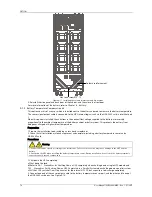
BATTERY
User Manual 10H52246UM60 - Rev. 1 - 01/2017
59
Table 6-6
BCB rated current and battery max. discharge current at full load
(recommended)
Item
Unit
UPS rating (kVA)
60kVA
30-block
battery
Max. battery discharge current at full load
A
195
Reference rated current of BCB
A
200
32-block
battery
Max. battery discharge current at full load
A
170
Reference rated current of BCB
A
200
34-bolck
battery
Max. battery discharge current at full load
A
160
Reference rated current of BCB
A
200
36-block
battery
Max. battery discharge current at full load
A
150
Reference rated current of BCB
A
200
38-block
battery
Max. battery discharge current at full load
A
140
Reference rated current of BCB
A
200
40-block
battery
Max. battery discharge current at full load
A
135
Reference rated current of BCB
A
200
Refer to Figure 6-5 for the connections between the battery, BCB and UPS.
+
N
-
+
N
-
UPS
N
N
U
P
S
Figure 6-5
Connections between the battery, BCB and UPS
6.11
Battery Maintenance
For battery maintenance procedures and precautions, refer to IEEE-Std-1188-2005 and the manuals provided by the
battery manufacturer.
Note
1. Periodically check the battery terminal connection screws and ensure that they are firmly tightened. Tighten any loose
screws immediately.
2. Ensure that all safety devices are in place and function correctly, and that the battery management parameters have been
set-up correctly.
3. Measure and record the air temperature inside the battery room.
4. Check the battery terminals for signs damage or overheating, and that the battery enclosures and terminal shields are
intact.
6.12
Disposing of Used Batteries
If the battery leaks or is damaged, place it in a container that can withstand sulfuric acid and dispose of it in
accordance with the local regulations.
Used lead acid accumulator batteries are classified as dangerous waste, and correct disposal is a very important
factor in used battery pollution management. Storage, shipping, handling, use and disposal of batteries must comply
with the national and local laws and regulations regarding dangerous waste and prevention of used battery pollution,
and other standards.
According to the relevant national regulations, used lead acid accumulator batteries must be recycled and may not
be disposed of by any other method. Uncontrolled dumping or any other improper disposal of used lead acid
accumulator batteries can cause severe environmental pollution and render the transgressor liable to prosecution.
















































